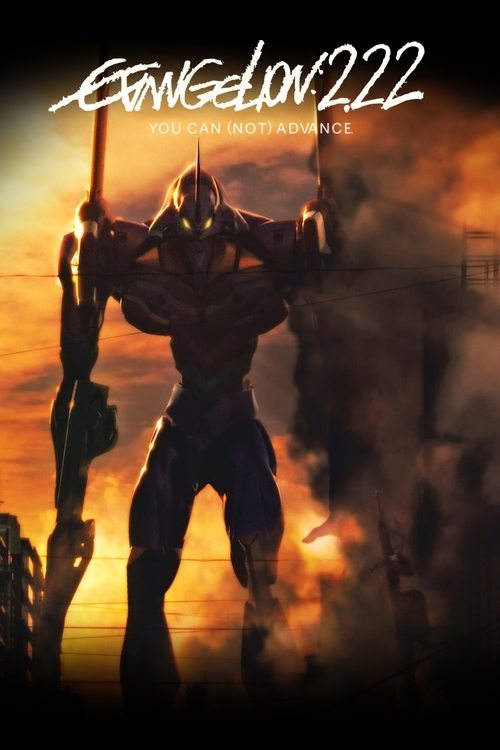
Evangelion: 2.0 You Can (Not) Advance
Under constant attack by monstrous creatures called Angels that seek to eradicate humankind, U.N. Special Agency NERV introduces two new EVA pilots to help defend the city of Tokyo-3: the mysterious Makinami Mari Illustrous and the intense Asuka Langley Shikinami. Meanwhile, Gendo Ikari and SEELE proceed with a secret project that involves both Rei and Shinji.
Dialogues from Movie Evangelion: 2.0 You Can (Not) Advance
Quotes from Movie Evangelion: 2.0 You Can (Not) Advance
Sound Tracks from Evangelion: 2.0 You Can (Not) Advance by Shirō Sagisu
Beautiful World
Beautiful World by Hikaru Utada, End credits theme
Thank You
Thank You by Hikaru Utada, Featured during emotional moments
Download App
Memorable Scenes from Movie Evangelion: 2.0 You Can (Not) Advance
Shinji's Struggle
In this opening scene, we see Shinji Ikari struggling to find his place in the world. After fighting alongside the Eva units, he is haunted by doubt and fear. The tension builds as he contemplates whether he truly wants to pilot the Eva or if he's just trying to impress his father, Gendo. This emotional conflict reaches a peak when he shouts in frustration, questioning his own worth and purpose. The visuals are stark, highlighting his isolation against the cold backdrop of NERV headquarters. The aftermath of this moment deepens Shinji's character, pushing him toward a journey of self-discovery. The audience feels his heartbreak and vulnerability, making his struggle relatable and poignant.
Context: This scene sets up the internal conflict that drives Shinji's character throughout the movie. It showcases his deep-seated insecurities and desire for connection, contrasting sharply with the high-stakes battles he faces.
Rei and Shinji
A quiet moment between Rei Ayanami and Shinji occurs on a rooftop as they look out over Tokyo-3. This scene feels heavy with unspoken words, as Rei's enigmatic presence contrasts with Shinji's emotional turmoil. The pivotal moment happens when Shinji asks Rei about her feelings, and she responds ambiguously, leading him to question his understanding of her. The close-up shots capture their expressions, showing Shinji’s desperate need for connection and Rei’s cold detachment. This interaction impacts the story by highlighting Shinji's longing for someone to understand him, and also hints at Rei's own complex nature. Viewers are left feeling a mix of hope and sadness, resonating with the idea of unreciprocated feelings.
Context: This conversation captures the essence of Shinji’s struggles with relationships. It emphasizes the difficulties of understanding others, especially when emotions are involved, a recurring theme in the film.
Instrumentality Begins
The climactic scene of Instrumentality draws characters and viewers alike into a surreal exploration of identity and consciousness. As souls merge, viewers witness visions of each character's innermost fears and desires. The emotional weight peaks as Shinji confronts his own loneliness and the fear of rejection. The visuals are a mix of abstract art and familiar settings that reflect personal memories. The aftermath of this scene breaks down the walls between characters and the audience, allowing everyone to feel a shared experience of vulnerability. Viewers are left with feelings of confusion, melancholy, and, ultimately, a sense of catharsis as they contemplate their own existential thoughts.
Context: Instrumentality serves as a turning point for every character, raising questions about individuality versus connection. It reflects the film's central themes of understanding oneself and others.
Asuka's Breakdown
Asuka Langley Soryu’s emotional collapse during an Eva battle captures the raw intensity of her character. The build-up shows her overconfidence as she boasts about her abilities, only to face a terrifying opponent that challenges her. The pivotal moment comes when, after being overpowered, Asuka is left in a state of despair. The visuals transition from vivid action to intimate close-ups of her tears and expressions of rage, anger, and fear. The aftermath reveals her deep-seated insecurities, shaking her confidence and leaving her emotionally vulnerable. This scene evokes feelings of empathy and heartbreak, as audiences witness her inner turmoil and fragility.
Context: This moment emphasizes Asuka's struggles with pain and vulnerability, drawing parallels to themes of self-worth and recognition in the film.
Gendo's Revelation
The moment Gendo Ikari reveals his true intentions to Shinji is rife with tension and emotional gravity. The build-up consists of subtle hints throughout the film, where Gendo’s cold demeanor contrasts with his deep, yet hidden, motivations. The pivotal moment hits hard when Gendo admits he desires Instrumentality to reunite with his deceased wife, Yui. The atmosphere thickens, and the stark lighting emphasizes the emotional rift between father and son. This confrontation irrevocably alters Shinji’s perception of his father and their relationship, making him realize the price of Gendo's ambitions. Viewers are left shaken, feeling a complex mix of anger and sorrow for both characters.
Context: Gendo's revelation serves as a turning point for Shinji, as it brings to light the complex dynamics of their father-son relationship and the themes of isolation and longing.
The Final Battle
The climactic confrontation between Eva Unit-01 and the Angels is a breathtaking spectacle of animation and emotion. As the battle ensues, viewers see Shinji grappling with his feelings of inadequacy while fighting for survival. The pivotal moment occurs when he taps into his deepest fears and desires, allowing him to channel immense power. The animation reaches a peak with explosive visuals and poignant sound design. The aftermath shows a resolution for Shinji, embracing his connection to others and realizing his strength. This scene resonates deeply with audiences, sparking feelings of exhilaration and triumph.
Context: The final battle encapsulates the movie's themes of overcoming personal barriers and the strength that comes from connection, making it a defining moment in the story.
Misato's Sacrifice
In a pivotal moment, Misato Katsuragi confronts the dire consequences of war and her responsibilities. As she guides Shinji and others to safety, her vulnerability becomes evident. The emotional peak hits when she realizes she may not survive the situation. With fierce determination, she sacrifices herself to protect her friends. The visuals are striking, displaying her bravery amidst destruction. This moment impacts the narrative greatly as it drives Shinji’s character development, showcasing the depth of his relationships. Viewers are left heartbroken but inspired by Misato's courage, invoking feelings of respect and sorrow.
Context: Misato's sacrifice underscores the theme of selflessness in times of crisis, highlighting the importance of sacrifice and companionship in the film.
Shinji Meets Kaworu
The moment Shinji encounters Kaworu Nagisa is both serene and haunting. The build-up is filled with tension as Shinji discovers this enigmatic boy who seems to understand him like no one else. When they share a profound conversation about loneliness and understanding, the pivotal moment occurs when Kaworu expresses his desire to be close to Shinji. The atmosphere is calm, with soft lighting, contrasting with Shinji’s chaotic world. The aftermath of this meeting is heavy, as it foreshadows tragedy and connection. The audience feels joy in their rapport but also a looming sense of dread and heartbreak as they anticipate the inevitability of their fate.
Context: This scene lays the foundation for Shinji's emotional journey, exploring themes of love, acceptance, and the tragic nature of human connections.
The Gigantic Eva
The shocking reveal of the gigantic Evangelion prototype, which represents the culmination of humanity's struggle against the Angels, leaves a profound impact. The build-up leads to this moment as the characters face insurmountable challenges. The pivotal moment is marked by the raw, overwhelming power of the Eva unleashed in battle. The visuals are grand, showcasing the new form in all its glory against a bleak landscape. This transforms the narrative as viewers realize the lengths humanity will go to survive. The sheer scale evokes feelings of awe and fear, resonating with the audience's consciousness of sacrifice and existential threats.
Context: This moment emphasizes the theme of human desperation in the face of seemingly unstoppable forces, and acts as a metaphor for the struggles faced throughout the film.
Shinji's Choice
In the crucial moment where Shinji must decide the fate of humanity, the scene portrays an intense internal struggle. The build-up is laden with emotional weight as Shinji grapples with his self-worth. The pivotal moment occurs when he declares what he truly wants, breaking free from the cycle of pain. The visuals are a mix of ethereal beauty and stark contrast, illustrating the choices ahead. The aftermath of this choice acts as a transformative event for both Shinji and the audience, enforcing the weight of personal agency. Viewers are left feeling a mixture of hope and anxiety, resonating with the weight of decisions in their own lives.
Context: This scene encapsulates the film's central theme of choice and the significance of personal agency, marking a profound development in Shinji's character.
Toji's Fate
The moment when Toji Suzuhara becomes the target of an Angel attack is heart-wrenching. The build-up shows his earlier moments of camaraderie with Shinji, which make his fate all the more tragic. The pivotal moment occurs when he realizes he must pilot the Eva, leading to his horrifying transformation. The tension is palpable as viewers wish for a different outcome. The aftermath is devastating, showcasing Shinji’s grief and guilt. This scene evokes profound sadness and anger at the senseless loss, leaving audiences reflecting on the cost of war.
Context: Toji's fate serves as a stark reminder of the collateral damage in battles, emphasizing the theme of loss and the stakes of human connections.
The Dance of Angels
The scene depicting the surreal and poetic dance of the Angels embodies both beauty and terror. The build-up heightens with the contrasting serenity of the visuals and the impending destruction. The pivotal moment of realization strikes when characters witness the Angels’ power firsthand. The animation showcases stunning artistry, making viewers spellbound by the dance while feeling a dread for what is to come. The aftermath highlights the fragility of life in the face of such beauty and horror. This scene evokes wonder and fear, lingering in the minds of the audience long after it ends.
Context: The dance of Angels symbolizes the duality of existence, encapsulating the beauty of life alongside the threat of annihilation.
The Reunion of Old Friends
In a heartwarming moment, Shinji reunites with an old friend during a break in the chaos. The build-up leads to shared memories, contrasting with their current struggles. The pivotal moment occurs as they reminisce and laugh about their past; camaraderie fills the space momentarily. The visuals are warm and inviting amid the madness. This emotional moment heightens the stakes as their friendship becomes a source of hope. The aftermath leaves viewers feeling uplifted, even amid turmoil. It's a poignant reminder of the connections that provide solace in dark times.
Context: This reunion emphasizes the strength of friendship and the importance of human connection, reinforcing central themes throughout the film.
The Eva Awakens
The moment when Evangelion Unit-01 awakens is a breathtaking spectacle filled with awe and fear. The build-up is filled with anticipation as the characters face threats. The pivotal moment occurs when the Eva suddenly springs to life, showcasing unfathomable power. The visuals are electrifying, portraying the Eva in a near-divine light. The aftermath dramatically changes the battle dynamics, raising the stakes for everyone involved. Viewers are left exhilarated, feeling the blend of fear and hope at the presence of this monstrous power.
Context: The awakening symbolizes humanity's potential and resilience, aligning with the film's themes of evolution and overcoming obstacles.
The Birth of a New World
In this climactic scene, the events of Instrumentality reach their zenith depicted through abstract visuals and emotional confrontations. The build-up involves characters wrestling with their own identities and relationships. The pivotal moment is when Shinji makes his final choice about existence, leading to a beautiful yet haunting visualization of a new world. The aftermath reshapes the characters' realities, symbolizing rebirth. This scene evokes a strong sense of catharsis and haunting beauty, making viewers reflect on their own lives and choices.
Context: The birth of a new world represents the film's core themes of hope, rebirth, and the struggle for understanding in human existence.
Shinji's Confrontation with Gendo
The emotional confrontation between Shinji and Gendo hits hard as it encapsulates their strained father-son dynamic. The build-up showcases Shinji’s long-standing anger and confusion concerning his father's desires. The pivotal moment happens when Shinji breaks down, demanding clarity and acknowledgment. The visuals intensify with close-up shots capturing their emotional expressions tightly. The aftermath is transformative, leading Shinji to confront his own choices, while Gendo faces the consequences of his actions. The scene elicits feelings of frustration, sorrow, and bittersweet acceptance from viewers, deeply impacting their perception of both characters.
Context: This confrontation crystallizes the relationship between Shinji and Gendo, unearthing the deep regrets and ambitions that drive their actions.
The Lament of Yui
In the emotional sequence revealing Yui's presence in the Eva, viewers discover her legacy and sacrifice. The build-up constructs a sense of mystery surrounding her character as the truth unfolds. The pivotal moment arrives when Yui explains her love for Shinji and her hope for humanity, filled with raw emotion. The visuals are poignant, straddling the line between nostalgia and heartbreak. The aftermath resonates with themes of loss and love, strengthening the emotional bond between Shinji and his mother. Viewers feel a mix of grief and hope, reflecting on the significance of familial connections.
Context: Yui’s lament emphasizes the themes of longing, familial love, and the sacrifices made for one's offspring.
The Burden of Choice
The moment where characters must grapple with their choices exemplifies a central theme in the film. The buildup involves intense discussions about the nature of existence and relationships. The pivotal moment occurs when they must decide whether to pursue their own happiness at the cost of others. The visuals reflect their inner turmoil, juxtaposed against a backdrop of looming destruction. The aftermath reveals the weight of their decisions, shaping their futures. This scene resonates deeply, evoking a sense of empathy and contemplation about the nature of selflessness versus personal desire.
Context: This moment solidifies the theme of existential choice, forcing characters and viewers alike to confront what it means to truly live.
The Emotion of Loss
A haunting moment reflecting on loss showcases characters mourning those they’ve lost in battle. The buildup establishes a somber tone, emphasizing the heavy cost of their fight. The pivotal moment arrives as each character expresses their grief, leading to cathartic release. The visuals are striking, pairing lush animation with stark imagery of those they’ve lost. The aftermath highlights the emotional toll of their battles and the connections forged through suffering. Viewers are left grieving alongside the characters, feeling the shared weight of loss and sorrow.
Context: This moment serves as a deeply emotional exploration of loss, underscoring the cost of conflict and the bonds formed through shared experiences.
Facing the Truth
An emotionally charged scene where characters confront hidden truths about themselves and each other takes center stage. The buildup leads to escalating tensions among the group, culminating in a heated exchange. The pivotal moment finds each character revealing their fears and insecurities, bringing vulnerability to the forefront. The visuals convey raw emotion through animation and expression, drawing viewers into their conflicts. The aftermath reshapes relationships, leading to newfound understanding. Viewers resonate with the cathartic release, feeling a strong connection to the themes of vulnerability and honesty.
Context: This scene emphasizes the significance of facing personal truths, encapsulating the film's exploration of identity and relationship dynamics.
The Fragility of Human Connections
In this scene, characters reflect on the nature of their relationships, highlighting the fragility of human connections. The buildup occurs through dialogues about trust and support, leading to a tense yet revealing moment. The pivotal point arrives when a character admits their fears about losing their friendships. The visuals capture intimate expressions that echo their fears and desires, pulling viewers into their emotional turmoil. The aftermath leads to strengthened bonds and a deeper understanding of interpersonal relationships. This scene evokes empathy and introspection, reminding audiences of the importance of nurturing connections.
Context: This moment captures the essence of human relationships within the film, resonating with themes of love, fear, and vulnerability.
Evil’s True Face
The reveal of the true nature of the Angels during a pivotal battle is a shocking moment that changes everything. The build-up involves suspense as the characters analyze their opponents' motivations. The pivotal moment occurs as the Angel's real form is unveiled, forcing the characters to confront their assumptions. The shocking visuals are both beautiful and horrifying. The aftermath radically shifts the narrative, forcing characters to reevaluate their understanding of good and evil. The viewers are left in a state of shock, questioning moral binaries.
Context: This moment emphasizes the film’s exploration of morality, depicting complexities that lie beneath the surface in a world of conflict.
Descending into Despair
As Shinji faces the consequences of his choices, this scene portrays his descent into despair. The buildup consists of a series of failures and heartbreaks that culminate in this moment. The pivotal moment occurs when he finds himself isolated, unable to cope with his feelings of worthlessness. The visuals shift to dark tones, emphasizing his inner turmoil and loneliness. The aftermath leaves Shinji at a crossroads, struggling to find his way back toward hope. Viewers feel profound sadness and empathy, resonating with the theme of mental struggle.
Context: This moment emphasizes the emotional impact of despair, reflecting the challenges of self-acceptance and the search for meaning.
Resolution Through Understanding
In the film's concluding moments, characters come to a collective understanding about their struggles. The gradual buildup incorporates their experiences and growth. The pivotal moment occurs when they collectively decide to embrace their flaws and connections with one another. The visuals convey a sense of warmth and acceptance, culminating in a harmonious atmosphere. The aftermath fosters a powerful sense of closure, urging viewers to reflect on their own relationships. The emotion evokes catharsis and hope, marking a poignant end to their journey.
Context: This scene embodies the film's ultimate message of connection, acceptance, and the importance of shared experiences in overcoming life's challenges.
Download App










